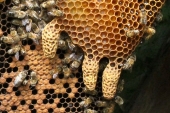
























Thank you, I will check every other day now and when I see eggs, I will transfer the nuc into a full size colony. I put two fresh frames of brood from another colony into this nuc so they have a continuous supply of new workers hatching.Troy Rhodes wrote:It's 2-3 weeks after she hatches, and 2-3 days after she takes the mating flight.
I check 3 times per year now, whether they need it or not. Or if I think there is funny business going on...
 1
1








Troy Rhodes wrote:Every time you open the hive, you set them back 1/2 a day or so.
find religion! church
kiva! hyvä! iloinen! pikkumaatila
get stung! beehives
be hospitable! host-a-hive
be antisocial! facespace









find religion! church
kiva! hyvä! iloinen! pikkumaatila
get stung! beehives
be hospitable! host-a-hive
be antisocial! facespace









find religion! church
kiva! hyvä! iloinen! pikkumaatila
get stung! beehives
be hospitable! host-a-hive
be antisocial! facespace









find religion! church
kiva! hyvä! iloinen! pikkumaatila
get stung! beehives
be hospitable! host-a-hive
be antisocial! facespace
 1
1









|
Give a man a gun and he'll rob a bank. Give a man a bank and he'll rob everyone. Even tiny ads:
GAMCOD 2025: 200 square feet; Zero degrees F or colder; calories cheap and easy
https://permies.com/wiki/270034/GAMCOD-square-feet-degrees-colder
|
